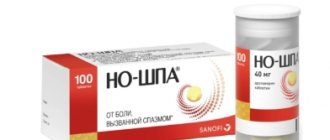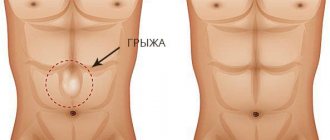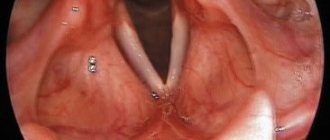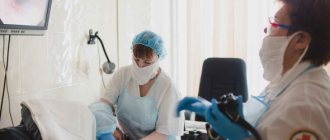Home » Department of Surgery » Procedures » Vagotomy
Vagotomy is an operation that involves cutting the main trunk or branch of the vagus nerve. This nerve, which is the X pair of cranial nerves, contains sensory and motor nerve fibers. The vagus nerve branches into two trunks: left and right. The left vagus nerve runs along the anterior surface of the esophagus, and the right one along the back. The vagus nerve enters the abdominal cavity through the esophageal or aortic opening in the diaphragm. These nerve trunks give branches to the liver, stomach and other internal organs. Descending to the stomach, the right and left branches of the vagus nerve give rise to many branches that spread over its surface and are called Laterger branches.
In the treatment of gastric and duodenal ulcers, this type of surgery has been used since the beginning of the 20th century. The positive effect on the course of the disease is due to a decrease in stimulation of the parietal cells of the stomach. Normally, these cells produce hydrochloric acid, which is necessary for digestion in the stomach. However, with a peptic ulcer, the production of this substance becomes excessive, which provokes the progression of the ulcer. After crossing the vagus nerve and its branches, this pathological factor is eliminated and a favorable environment is created for the healing of the ulcerative defect.
Vagotomy - Contraindications
In some conditions, vagotomy is not indicated or even contraindicated:
- Extremely high levels of acid-producing function of the stomach (in this case, vatomy may simply be ineffective)
- Disorders of the motor-evacuation function of the stomach
- Peritonitis
- Infectious diseases
- Bleeding in the abdominal cavity
- Decompensated stage of cardiopulmonary diseases
- Severe coagulopathies
- Malignant neoplasms
Vagotomy - preoperative preparation
Preoperative preparation for vagotomy involves a thorough examination of patients:
- Esophagogastroduodenoscopy is necessary in the diagnosis of peptic ulcer disease to assess the condition of the gastric and duodenal mucosa, examine the ulcerative defect of the organ wall, and monitor the dynamics of treatment. Gastroduodenal intubation allows you to assess the condition of the secretory apparatus of the stomach and duodenum. Fractional intubation is carried out with sampling of gastrointestinal juice on an empty stomach, after a test breakfast, and stimulation of secretion.
- X-ray examination of the stomach - helps in identifying ulcerative defects, assessing the motor-evacuation function of the stomach and duodenum.
Characteristics of certain types of diseases of the operated stomach. Postgastroresection syndromes
Dumping syndrome occupies a leading place among post-resection disorders. It occurs, according to various authors, in 3.5–38% of patients who underwent gastric resection according to Billroth II. The difference in statistical indicators is due to the lack of common views on the essence of the syndrome. The pathogenesis of dumping syndrome is complex. In its development, the main importance is attached to the accelerated evacuation of stomach contents and the rapid passage of food masses through the small intestine.
The entry of hyperosmolar food into the small intestine leads to a number of disorders:
- an increase in osmotic pressure in the intestine with the diffusion of fluid into its lumen and, as a consequence, a decrease in bcc;
- rapid absorption of carbohydrates, which stimulate excess insulin secretion, which first causes hyperglycemia and then hypoglycemia;
- irritation of the receptor apparatus of the small intestine, leading to stimulation of the release of biologically active substances (acetylcholine, kinins, histamine, etc.), an increase in the level of gastrointestinal hormones (secretin, cholecystokinin, motilin, vasoactive intestinal polypeptide, etc.).
The clinical picture of dumping syndrome includes a vasomotor component (weakness, sweating, palpitations, pallor or flushing of the face, drowsiness, increased blood pressure, dizziness, and sometimes fainting) and a gastrointestinal component (heaviness and discomfort in the epigastric region, rumbling in the abdomen, diarrhea, as well as nausea, vomiting, belching and other dyspeptic phenomena). These phenomena occur during a meal or 5–20 minutes after it, especially after eating sweet and dairy foods. The duration of attacks ranges from 10 minutes to several hours.
Based on the severity, it is customary to distinguish between mild, moderate and severe dumping syndrome.
Mild dumping syndrome is characterized by episodic, short-term attacks of weakness that occur after eating sweet and dairy foods. The patient's general condition is quite satisfactory, his performance does not decrease.
With dumping syndrome of moderate severity, pronounced vasomotor and intestinal disturbances occur after eating any food, especially sweet and dairy dishes, as a result of which the patient is forced to take a horizontal position. Performance decreases.
In severe dumping syndrome, almost every meal is accompanied by a pronounced and prolonged attack of weakness, dizziness or fainting. Working capacity sharply decreases, the patient becomes disabled.
Diagnosing dumping syndrome in the presence of characteristic symptoms does not cause difficulties. The rapid evacuation of barium suspension (“discharge”) from the gastric stump and accelerated passage through the small intestine, revealed by X-ray examination, and the characteristic glycemic curve after a carbohydrate load confirm the diagnosis.
Hypoglycemic syndrome (HS) is also known as late dumping syndrome and is essentially its continuation. HS occurs in 5–10% of patients.
It is believed that as a result of accelerated emptying of the stomach stump, a large amount of carbohydrates ready for absorption immediately enters the jejunum. The blood sugar level quickly and sharply rises, hyperglycemia causes a response from the humoral regulation system with excessive release of insulin. An increase in the amount of insulin leads to a drop in sugar concentration and the development of hypoglycemia.
Diagnosis of HS is based on the characteristic clinical picture. The syndrome is manifested by a painful feeling of hunger, spastic pain in the epigastrium, weakness, increased sweating, feeling of heat, palpitations, dizziness, darkening of the eyes, trembling of the whole body, and sometimes loss of consciousness. The attack occurs 2–3 hours after eating and lasts from several minutes to 1.5–2 hours.
The glycemic curve after a glucose load in most patients is characterized by a rapid and steep rise and an equally sharp drop in blood sugar concentration below the initial level.
HS is often combined with dumping syndrome, but can also be observed in isolation.
Afferent loop syndrome (ALS) occurs in 3–29% of cases after gastric resection according to Billroth II due to impaired evacuation of duodenal contents and the entry of part of the eaten food into the afferent loop of the jejunum rather than into the afferent loop.
SPP is divided into:
- functional, arising as a result of dyskinesia of the duodenum, adductor loop, sphincter of Oddi, gall bladder;
- mechanical, caused by an organic obstacle (defect in operating technique, loop bend, adhesions).
Clinically, SPP is manifested by bursting pain in the right hypochondrium shortly after eating, which subsides after fairly profuse vomiting of bile. Sometimes in the epigastric region a distended adductor loop of the jejunum is palpated in the form of an elastic, painless formation that disappears after profuse vomiting of bile. Persistent vomiting can lead to loss of electrolytes, poor digestion, and weight loss.
Diagnosis of SPP is based on X-ray examination. X-ray signs of the syndrome are a long delay of contrast in the afferent loop of the jejunum, a violation of its peristalsis, and expansion of the loop. Due to partial obstruction, radiographic identification of the afferent loop during barium administration is difficult. In these cases, soluble contrast can be administered using a catheter passed through the endoscope channel.
Peptic ulcers (PU) after gastrectomy can form in the anastomosis area from the gastric stump, jejunum or at the site of the anastomosis. PYs develop in 1–3% of operated patients (Kuzin N.M., 1987).
The time frame for the development of PJ in the anastomotic zone ranges from several months to 1–8 years after surgery. Reasons for their formation:
- economical resection;
- left area of the antrum of the stomach with gastrin-producing cells;
- gastrinoma or other endocrine pathology.
Clinical manifestations of PJ anastomosis resemble the symptoms of peptic ulcer disease. However, the disease usually occurs with more severe and persistent pain than before surgery, and complications in the form of bleeding and penetration of the ulcer are not uncommon.
X-ray and endoscopic examinations can confirm the diagnosis. As a rule, ulcers are found at the site of anastomosis, near it from the side of the stomach stump, less often in the efferent loop of the jejunum opposite the anastomosis.
Postgastroresection dystrophy (PD) often occurs after gastrectomy performed using the Billroth II method. Severe metabolic disorders that can be attributed to PD occur in 3–10% of cases (Samsonov M.A. et al., 1984). In their pathogenesis, the leading role is played by indigestion and absorption due to insufficiency of pancreatic secretion and damage to the small intestine. The diagnosis of PD is based primarily on clinical findings. Patients complain of rumbling and bloating, diarrhea. Symptoms of malabsorption are typical: weight loss, signs of hypovitaminosis (skin changes, bleeding gums, brittle nails, hair loss, etc.), cramps in the calf muscles and bone pain caused by disorders of mineral metabolism. The clinical picture can be supplemented by symptoms of damage to the liver, pancreas, as well as mental disorders in the form of hypochondriacal, hysterical and depressive syndromes.
In patients with PD, hypoproteinemia is detected due to a decrease in albumin levels, disturbances in carbohydrate and mineral metabolism.
Postgastroresection anemia (PA) is detected in 10–15% of patients who have undergone gastrectomy. PA comes in two variants:
— hypochromic iron deficiency anemia;
— hyperchromic B12-deficiency anemia.
The cause of iron deficiency anemia in most cases is bleeding from peptic ulcers of the anastomosis and erosions of the mucous membrane during reflux gastritis, which often occur hidden. The development of this variant of anemia is facilitated by impaired ionization and resorption of iron due to accelerated passage through the small intestine and atrophic enteritis. After removal of the stomach, the function of producing internal factor is lost, which sharply reduces the utilization of vitamin B12, as well as folic acid. This is also facilitated by changes in the composition of the intestinal microflora. Deficiency of these vitamins leads to megaloblastic hematopoiesis and the development of hyperchromic anemia.
Differential diagnosis of PA is based on the study of peripheral blood and bone marrow. In the peripheral blood, with iron deficiency anemia, hypochromia of erythrocytes and microcytosis are observed, and with B12-deficiency anemia, hyperchromia and macrocytosis are observed. In a bone marrow smear with pernicious anemia, a megaloblastic type of hematopoiesis is detected.
Vagotomy - Performing the operation
Several surgical techniques have been developed:
- Truncal vagotomy - the scope of the operation consists of the intersection of both vagus nerves. In this version of the operation, the nerve trunks are isolated at the level of the esophagus
- Selective vagotomy - with this type of operation, the branches of the vagus nerve are intersected after the celiac trunk departs. This method of vagotomy allows one to preserve the influence of the vagus on the innervation of the small intestine, while inhibiting gastric secretion.
- Selective proximal vagotomy or highly selective vagotomy is performed with preservation of the Laterger branches, hepatic and celiac branches of the vagus nerve. Vagal denervation of only the upper two-thirds of the stomach is observed, which makes it possible to achieve the desired effect with a small number of complications.
The classic operation is performed using general anesthesia and making a midline incision from the xiphoid process of the sternum to the umbilical region. The postoperative period lasts 10-14 days.
In Israel, laparoscopic vagotomy is more often used. This operation does not require such a wide abdominal incision. Surgical intervention is performed through small punctures in the abdominal wall 2-3 mm long. Through 3-4 such holes, video lighting equipment is inserted into the abdominal cavity, to which a video camera is connected, transmitting the image to the monitor screen.
Sterile carbon dioxide is injected into the abdominal cavity to create a working space as the anterior abdominal wall is lifted above the internal organs. Thus, the surgeon manipulates the abdominal cavity using endoscopic instruments and sees his actions on the monitor. The branches of the vagus nerves are identified and their intersection is performed at the required level.
In addition to the classic intersection of nerve trunks, electrocoagulation and chemical vagotomy are also used. In the first option, a section of the vagus nerve is exposed to an electrocoagulator, which disrupts the integrity of the nerve fibers. During chemical vagotomy, a special solution based on novocaine and ethanol is injected into the area of the lesser curvature of the stomach. As a result of degenerative processes in the area of influence of the drug, the stimulating effect of the vagus nerve on the stomach cells in this area ceases.
Recommendations
- Jordan PH, Thornby J (September 1994). “Twenty years after parietal cell vagotomy or selective vagotomy, antrectomy for the treatment of duodenal ulcer. Final report." Anna.
Surg .
220
(3): 283–93, discussion 293–6. Doi:10.1097/00000658-199409000-00005. PMC 1234380. PMID 8092897. - Surgical treatment of perforated peptic ulcer
in eMedicine - Kuremu RT (September 2002). "Surgical treatment of peptic ulcer." East African Medical Journal
.
79
(9): 454–6. PMID 12625684. - Chang TM, Chan DC, Liu YK, Zou SS, Chen TH. (April 2001). "Long-term results of duodenectomy with highly selective vagotomy in the treatment of complicated duodenal ulcers." American Journal of Surgery
.
181
(4):372–6. Doi:10.1016/S0002-9610(01)00580-3. PMID 11438277. - Siu W.T., Tan K.N., Lo B.K., Chau S.H., Yau K.K., Yang G.P., Lee M.K. (October 2004). "Vagotomy and gastrojejunostomy for benign gastric outlet obstruction." Journal of Laparoendoscopic and Advanced Surgical Techniques.
Part A.
14
(5): 266–9. PMID 15630940. - Wyman A, Stuart RC, Ng EK, Chung SC, Li AK (June 1996). "Laparoscopic truncal vagotomy and gastroenterostomy for pyloric stenosis." American Journal of Surgery
.
171
(6):600–3. Doi:10.1016/S0002-9610 (95) 00030-5. PMID 8678208. - “Can stress trigger weight loss? — USATODAY.com.” USA Today
. 2007-07-02. Retrieved 2010-05-27. - ^ a b c
Lustig, Robert H.;
Pamela S. Hinds; Karen Ringwald-Smith; Robbin K. Christensen; Sue K. Caste; Randy E. Schreiber; Shesh N. Rai; Shelley Y. Lensing; Shengjie Wu; Xiaoping Xiong (June 2003). "Octreotide therapy for pediatric hypothalamic obesity: a double-blind, placebo-controlled study." Journal of Clinical Endocrinology and Metabolism
.
88
(6):2586–92. doi:10.1210/jc.2002-030003. PMID 12788859. - Flier J.S. (2004). "The Obesity Wars: Molecular Advances Confront a Growing Epidemic." Cell
.
116
(2):337–50. Doi:10.1016/S0092-8674 (03) 01081-X. PMID 14744442. - Boulpaep, Emile L.; Boron, Walter F. (2003). Medical physiologya: a cellular and molecular approach
. Philadelphia: Saunders. item 1227. ISBN 0-7216-3256-4. - Lustig, Robert H (November 2011). "Hypothalamic obesity after craniopharyngioma: mechanisms, diagnosis and treatment." Front-endocrinol (Lausanne)
.
2
(60): 60. doi:10.3389/fendo.2011.00060. PMC 3356006. PMID 22654817. - Williams DL, Grill HJ, Cummings DE, Kaplan DM. (December 2003). "Vagotomy separates short-term and long-term control of circulating ghrelin." Endocrinology
.
144
(12):5184–7. Doi:10.1210/en.2003-1059. PMID 14525914. - Boss, Thad J; Jeffrey Peters; Marco J. Patti; Robert H. Lustig; John G. Kral (April 2008). "Laparoscopic truncal vagotomy for weight loss: a two-center prospective study of safety and effectiveness." Surgical endoscopy
.
2008 Society of American Gastrointestinal and Endoscopic Surgeons (SAGES) Scientific Sessions Philadelphia, PA, USA, April 9–12, 2008 22
(1 Suppl): 191–293. Doi:10.1007/s00464-008-9822-2. Received June 17, 2013.CS1 maint: location (communication) - Lygidakis NJ (March 1984). "Posterior trunk vagotomy and superficial seromyotomy along the anterior flexure as an alternative to surgical treatment of chronic duodenal ulcer." Surgical gynecological obstetrician
.
158
(3):251–4. PMID 6422569. - Boi J, Lee NW, Koo J, Lam PH, Wong J, Ong BB (September 1982). "Emergency radical surgery for perforated duodenal ulcer: a prospective controlled study." Annals of Surgery
.
196
(3):338–44. Doi:10.1097/00000658-198209000-00013. PMC 1352612. PMID 7114938. - Boy J, Branicki FJ, Alagaratnam TT, Fok PJ, Choi S, Poon A, Wong J (August 1988). “Proximal vagotomy of the stomach. Preferred surgery for perforation in acute duodenal ulcer.” Source: Annals of Surgery.
.
208
(2):169–74. PMID 3401061. - https://www.pernicious-anaemia-society.org
Vagotomy - Complications
Since the intersection of the vagus nerves disrupts the innervation of not only the stomach, some postoperative complications are observed. Such postoperative conditions are especially pronounced during less selective procedures such as stem and selective vagotomy:
- Post-vagotomy syndrome
- Relapses of peptic ulcer of the stomach and duodenum
- Bleeding
- Wound infection
By the way, Israeli surgeons prefer selective proximal vagotomy as the safest.
Vagotomy, performed by experienced Israeli surgeons, is one of the effective methods of treating stomach and duodenal ulcers.
Please note that all form fields are required. Otherwise we will not receive your information. Alternatively use
Sorry. This form no longer accepts new data.
Features of patient selection for surgical treatment of peptic ulcer
In emergency situations (perforation, bleeding), the question is about the life and death of the patient, and here there is usually no doubt about the choice of treatment.
When it comes to planned resection, the decision must be very balanced and thoughtful. If there is even the slightest opportunity to manage the patient conservatively, this opportunity should be used. The operation can get rid of the ulcer forever, but it adds other problems (quite often manifestations occur, designated as operated stomach syndrome).
The patient should be informed as much as possible about both the consequences of the operation and the consequences of not taking surgical measures.







